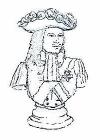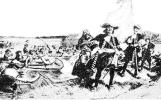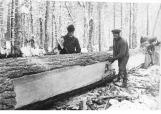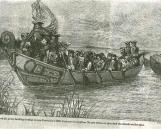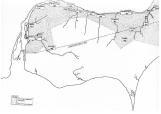2
IntroductionWhen Antoine de Lamothe Cadillac decided to set up a French colony in the Detroit River Region three hundred years ago, a rich and unique tradition of woodcarving was brought to south western Ontario that continues to this day. Ever since the earliest days of New France, crafting with wood was a common practice. In fact, Canada's lush forests contained perhaps the most important natural resources for the isolated settlers who began new lives in an unfamiliar land. The habitants, an ocean away from the old country, were unable to take many items with them on the long journey to their new homes. As a result, the new settlers turned to wood, a precious material that could be made into furniture, eating utensils, musical instruments, toys, and tools. The decoration of their churches with beautiful woodcarvings was important to the deeply Roman Catholic French immigrants.
Over the generations, a new kind of French 'folk art' - folk art meaning art of the common people - was created. Many decades after the first landing of the habitants, items important to everyday living were still being made of wood. French Canadians came to enjoy recording their life and times on pieces of wood. These wood pictures captured events and scenes of the French Canadian pioneers who established many colonies across North America, including one on the banks of the Detroit River. The wood pieces, then, can be compared to hand-made photographs that bring future generations closer to understanding a group of immigrants whose mark is still being felt today.
8
Mini altar and a wood cross with mother of pearl.1940
Amherstburg, ON Canada
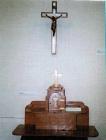 Credits:
Credits:Courtesy of Tony Rocheleau
10
Immigration to New FranceThe seeds of French Canadian wood art were planted over four hundred years ago when the determined explorer Jacques Cartier arrived at present-day Gaspé in 1534 and claimed the land for the King of France. The french soon formed a trading relationship with native groups for fur, a valuable commodity in the 16th century. By the 1600s, the government of France realized that establishing permanent trading posts in Canada would increase the haul of fur. As part of this plan, Samuel de Champlain was sent to organize a "habitation" at the site of present-day Quebec City.
Immediately after Champlain's arrival in 1608, Canada's rich forests proved to be an invaluable resource in the settlement's survival. Champlain and his party arrived in the new land with very few items needed for daily survival. They sailed in wooden ships that had limited space and transported limited amounts of cargo. The passengers were restricted to one wooden chest each. The chest usually contained small amounts of tools, utensils, seed, and a few personal items.
Space had to be made on the boat for farming equipment, livestock, and food.
Champlain's first priority upon landing was to build shelter as quickly as possible to shield his people from the ravages of the weather. Masons, carpenters, labourers, and locksmiths were among the twenty-eight men that accompanied him to New France. The rich forests that greeted the Frenchmen upon their arrival in Canada provided Champlain's men with the fastest way of constructing the new settlement. Indeed, the new wooden houses made of stacked cedar or spruce logs were built in a matter of days. The log cabins and one tiny wooden church were enclosed in a fence-like structure called a palisade. To give the habitation extra protection, the settlement was surrounded by a moat.
14
The Quebec Settlement ExpandsFrom the earliest days of the Quebec post, the trees became the major building material used by the French. Wood even played a vital role in the success of the Canadian fur industry. The French fur traders, following the example of the country's Aboriginal population, travelled in canoes constructed of birch bark. The need for wood and wood workers, however, increased dramatically after 1619. By that time, Samuel de Champlain had succeeded in convincing the French King and his Ministers to allow people of various trades and their families to move from France to the Quebec settlement. Champlain had argued that such an increase in immigration to Canada would result in expanding the fur trade. Furthermore, Champlain held that new settlers with a variety of skills could introduce new industries to New France such as farming, mining, and lumbering which would be of great financial benefit to France.
After 1619, the King set out to create a real French colony in Canada. He started the project by making grants of land to French noblemen. The nobles who owned lots of land in what became the province of Quebec were known as "seigneurs" or Lords. The seigneurs allowed tenants or "habitants" - meaning people living in a particular place - to farm the land. The habitant farmer in turn paid a fee to his seigneur for the right to farm on the seigneur's land. People of other trades including teachers, shopkeepers, and priests also chose to begin a new life in Canada. By the mid 1600s, the rise in New France's population had resulted in the establishment of three towns, Quebec, Montreal, and Trois Rivieres. The fur trade remained the major industry in New France. First Nations traders the furs primarily to posts in Montreal and Trois Rivieres in exchange for tools, guns, and alcohol. The furs were then transported to France.
In spite of the fact that the arrival of people with a variety of skills strengthened the colony, the French settlers still faced hardships that came from being so far from their country of origin. Like Champlain's original group of twenty-eight, the new colonists were unable to transport much of their personal belongings due to the limited space offered by French ships. Only the wealthiest of passengers were able to pay the hefty expense of shipping large items such as furniture to their new homes. Therefore, many of the early colonists, especially those living away from the towns, were forced to learn how to work with wood. They had to craft their own plates and bowls to hold traditional French dishes such as tortiere and pea soup. The handmade wood furniture was generally very simple in design. The ordinary habitant lacked both time and formal training to do any fancy work. The arrival in Quebec of a persistent Bishop from France in the early 1670s, however, would soon transform this crude mode of wood crafting into a distinctly French Canadian art form.
